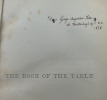KETTNER'S BOOK OF THE TABLE.
KETTNER'S BOOK OF THE TABLE. A MANUAL OF COOKERY. PRCTICAL - THEORETICAL - HISTORICAL. Written in George Augustus Sala's small neat hand - "The literary and critical portion of this book was written by my very dear friend Enaeas S. Dallas, sometime of the " Times" Newspaper and Editor of "Once a Week". A poem form Paradise Regained. Somewhat obscured by stencilled holes of the FORBES LIBRARY. NORTHAMPTON. MASS. LONDON. DULAU AND CO. SOHO SQUARE.1877. A poem form Paradise Regained. Somewhat obscured by stencilled holes of the FORBES LIBRARY. NORTHAMPTON. MASS. LONDON. DULAU AND CO. SOHO SQUARE.1877.
FIRST AND SOLE EDITION. Marbled end-papers with Forbes Library bookplate. On verso -1 fep. 1p Half-title - THE BOOK OF THE TABLE and an inscription in Sala's neat hand - George Augustus Sala, 46 Mecklenburg Sq. W.C. 1878. On verso a two-line poem from Paradise Regained. Title Page. [1]. 1p dedication to GEORGE AUGUSTUS SALA. [1]. 1-16 Introduction. 1p Half-title - THE BOOK OF THE TABLE. [1]. 19-500. 4 blanks for Notes. 1fep. Marbled end papers, Old red marbled boards with red leather quarter binding and tips, all with gilt lines. Red leather spine compartmentalised with dull gilt tooling. Internally a little brown aged but overall very clean. Also enclosed: 1p. 7x4.5 inches with minor creases. From the Reform Club 24th January - no year given. An autograph letter signed: "G.A. Sala to G.Linnaeus Banks, sending 'a doz. stamps for Shakespeare heads" and mentioning the Shakespeare committee business" Internally a little brown aged but overall very clean. Also attached: 1p. 7x 4.5 inches with minor creases. From the Reform Club 24th January - no year given. An autograph letter signed: "G.A. Sala to G.Linnaeus Banks, sending 'a doz. stamps for Shakespeare heads" and mentioning the Shakespeare committee business"
- Kettner’s was one of the first and oldest French restaurants in London. Opened in Romilly Street in Soho 1867 by August Kettner, known as a very fastidious chef to Napoleon III. English aristocracy in waistcoats, and in love, would bring their wives and their mistresses to try Kettner's French cuisine for the first time – feasts of carp fillets à la Duxelle, fried Gudgeon with asparagus in cream, devilled Kidney and thick Eel stews, all followed by Apple and Almond tarts for dessert. Ever popular with historical figures throughout its gilded history. King Edward VII is said to have courted his mistress, actress Lillie Langtry, there. They say that the philandering King had a secret underground passageway built between the restaurant and the Palace Theatre next door, so that his mistress could slip away after performances for an intermission of supper downstairs and a final act in the private rooms upstairs. The lounge and Champagne Bar have welcomed visitors including Oscar Wilde wining and dining the rent boy Charles Parker, Agatha Christie tucking into a bouillabaisse, Sir Winston Churchill, Margaret Thatcher and Bing Crosby among others. Kettner’s wasn’t just part of Soho, it was Soho. It was the sordidness and the sobriety. Rising up around the restaurant over generations, Soho was built and re-built to be London’s den of iniquity. Today, a more discreet and gentile Kettner’s comprises seven Georgian townhouses, including the Grade II-listed club space and two bars, all carefully restored with close attention to original features and details. On the three top floors are 33 bedrooms and the Grade II-listed Jacobean Suite, with its own private entrance. The Kettner’s well known art collection is inspired by the buildings’ former risqué reputation. Now, as is the way of the world, the restaurant is re-branded, re-born. The continuation of the Kettner name may serve only as a wink to the past and a nod to the future, in the sober but still vibrant district of Soho. E.S. Dallas [Enaeas Sweetland Dallas] was the author of Kettners 'Book of the Table' and was a very good friend of Sala's. G.A. Sala, born in London, tried his hand at writing, at a very early date and in 1851 attracted the attention of Charles Dickens, who published articles and stories by him in Household Words and subsequently in All the Year Round, and in 1856 sent him to Russia as a special correspondent. In 1860, over his own initials "G.A.S.", he began writing "Echoes of the Week" for the Illustrated London News, and continued to do so till 1886, when they were continued in a syndicate of weekly newspapers almost to his death. William Makepeace Thackeray, when editor of the Cornhill, published articles by him on Hogarth in 1860, which were issued in column form in 1866; and in the former year he was given the editorship of Temple Bar, which he held till 1863. Meanwhile, he had become in 1857 a contributor to The Daily Telegraph, and it was in this capacity that he did his most characteristic work, whether as a foreign correspondent in all parts of the world, or as a writer of "leaders" or special articles. His literary style, highly coloured, bombastic, egotistical and full of turgid periphrasis, gradually became associated by the public with their conception of the Daily Telegraph; and though the butt of the more scholarly literary world, his articles were invariably full of interesting matter and helped to make the reputation of the paper. Sala died at Brighton on 8th December, 1895. In an email I received from Linda Gifkins, she kindly informed me of a hitherto unknown edition of Sala's quite rare book 'The Thorough Good Cook', printed by Brentano's - New York, Chicago, Paris, & Washington in 1896. Sala was twice married. His first wife, Harriet, whom he married in September 1859, died at Melbourne in December 1885. In 1891 he married a second wife, Bessie, third daughter of Robert Stannard, C.E., who survived him.






click on image to enlarge

Antiquarian category
ref number:
11251